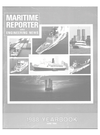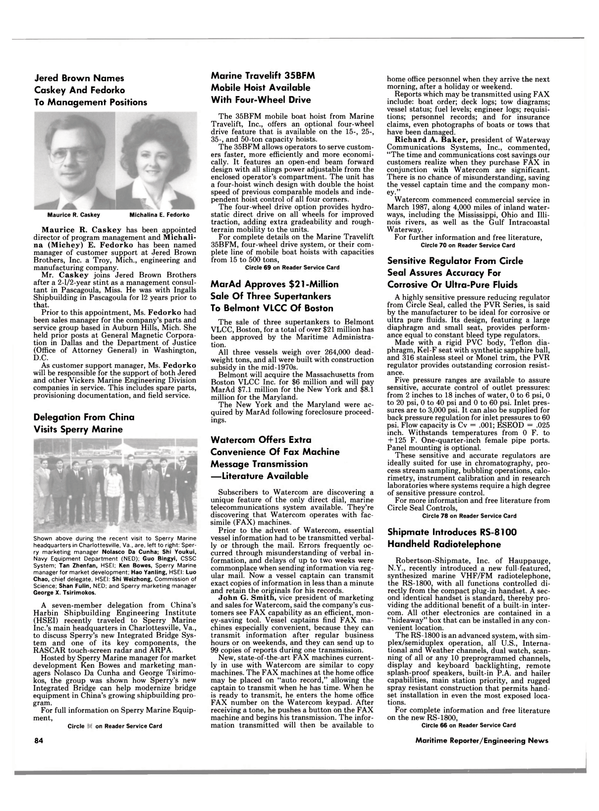
HDW Christens Two Containerships For American President Lines
First Two Ships Of N e w Class Of Five American President Lines (APL) recently christened two 902-foot containerships of a new class of five vessels at Howaldtswerke-Deutsche Werft (HDW) in Kiel, West Germany.
The fuel-efficient C-10 Class ships, each capable of carrying the equivalent of 4,300 TEU containers, have an efficient new "wide-body" hull design and are propelled as fast as 24 knots by some of the largest, most powerful diesel engines ever built.
The ships, the President Kennedy and President Truman, have a 129- foot beam, maximum draft of 41 feet, displacement of 75,862 long tons and a deadweight of 53,648 long tons. The vessels have been classed by the American Bureau of Shipping, +AI E, Container Carrier + AMS + ACCU. The vessels will be used in APL's Pacific Basin service.
Bruce Seaton, chairman of California- based American President Companies (APC), APL's parent organization, said the ClOs will become a key component in the company's complex land and sea distribution system.
During a ceremony at HDW, Hannelore Kohl, wife of West German Chancellor Helmut Kohl, christened the M.V. President Kennedy.
The M.V. President Truman was christened by Joyce Seaton, Bruce Seaton's wife.
A third CIO, the President Jackson, is nearing completion in the HDW yard, while two additional ClOs are being constructed by Bremer-Vulkan, of Bremen. The President Truman will be the first to enter service, while the remaining four ClOs will be phased into service later this year.
The CIO ships are the first container- carrying vessels to have a "post-Panamax" beam, meaning their width exceeds the limitations of the Panama Canal. As with the development of wide-bodied aircraft, the increased capacity and efficiency requirements for these vessels led to the new design concept.
APL president Timothy J.
Rhein said the company's focus on the Pacific Basin and Indian Ocean regions, coupled with American President's extensive intermodal (rail and truck) service to the Midwestern and Eastern regions of North America, made it possible to design ships unconstrained by the canal's dimensions.
"These are the first ships to be designed specifically for trans-Pacific service," Mr. Rhein said. "By removing the limitation on the ships' beam, we were able to significantly increase their capacity, while optimizing their speed, fuel efficiency, and stability." The 129-foot beam makes it possible to load containers 12 rows across, below deck, and 16 rows across, above deck, compared with a maximum of 10 rows below deck and 13 rows above deck for ships of a traditional "Panamax" design.
The greater stability achieved as a result of the wide beam also enables APL to stack containers five-high above deck, while eliminating the need to carry excessive water ballast during trans-Pacific voyages—a drag on vessel performance. It also means the ships can be loaded and unloaded more quickly, because containers can be stowed on the basis of logistical efficiency, with less regard for weight.
Each CIO is propelled by a 57,000 horsepower, 12-cylinder diesel engine— the most powerful internal combustion engine ever built. Designed by Sulzer of Switzerland, and manufactured in Korea, these power plants meet APL's high servicespeed requirement with a single propeller, eliminating the need for less fuel-efficient twin-propulsion systems.
By replacing smaller, less efficient ships, the ClOs will help the company reduce marine costs on a per container- mile basis by 50 percent from 1984 levels, Mr. Rhein said. The ClOs will contribute to an annual eastbound capacity increase of approximately 24 percent in 1988, which includes the full-year impact of four other large, diesel-propelled vessels introduced in April 1987, and by an additional 17 percent in 1989.
For free literature on the shipbuilding services of HDW, Circle 12 on Reader Service Card
Read HDW Christens Two Containerships For American President Lines in Pdf, Flash or Html5 edition of June 1988 Maritime Reporter
Other stories from June 1988 issue
Content
- Castrol Offers Free 56-Page Lube Oil Guide & World Service Directory page: 6
- ODECO's Hugh J. Kelly Elected Chairman Of NOIA At 16th Annual Meeting page: 7
- $4.3 Million To Peterson Builders To Administer Navy Parts Acquisition page: 8
- John Kristen Joins Ingram Barge Company page: 10
- Service Marine Christens 600-Passenger Paddlewheeler For Heritage Cruise Lines page: 10
- World's Largest Railway/Freight Ferry Launched By Seebeckwerft page: 11
- NASSCO Announces Production Management Realignment page: 11
- SPD Technologies Negotiating To Acquire Navy Division Of Brown Boveri Power Equipment Inc. page: 11
- Munson Manufacturing Launches Alaskan Excursion Boat For Holland America-Westours page: 12
- MSC Awards Contracts Totaling $154.2 Million page: 14
- 1,000th Golar Marine Incinerator To Be Installed page: 14
- Skuld Undergoes Major Changes In Structure page: 15
- Report 'Genesis System' Can Produce Record Fuel Savings For Vessel Owners page: 16
- Bailey Controls Completes Installation Of N e w Flow Calibration Laboratory page: 16
- Houma Fabricators A w a r d e d Contract For Vehicle-Passenger Ferry page: 17
- Brochure Available On N e w Sound Absorption Material From Soundcoat page: 18
- John M. Stebbins Named VP, Sales And Marketing Of Alco Power Inc. page: 18
- Gladding-Hearn Receives Order For INCAT-Design Passenger Ferry For N e w York Commuter Service page: 20
- SPD Technologies Names Biancamano Manager, International Marketing page: 20
- Intertek Offers Free Eight-Page Full-Color Brochure On Services page: 21
- Blount Christens 'Spirit Of Chicago' —7th Luxury Dinner Vessel In 'Spirit' Line For Cruise International page: 22
- Marathon LeTourneau Introduces New GulfKing Class Jackup For Gulf Of Mexico page: 23
- THE $34-BILLION ANNUAL U.S. NAVY MARKET page: 24
- SHIPBUILDING AND REPAIR IN U.S. SHIPYARDS page: 40
- The Tug And Barge Industry Provides A Wealth Of Benefits To American Consumers page: 44
- BARGE INDUSTRY WAITS FOR CONGRESSIONAL ACTION ON HIGHWAY DIESEL TAX page: 44
- REVIEW AND OUTLOOK page: 62
- World Shipbuilding page: 64
- Cummins-Powered Paddlewheeler Delivered By Superior Boat Works page: 76
- Leslie Controls Announces DLO-1 Series 80 Valves page: 77
- Aeroquip Offers Hydraulic Troubleshooting Bulletin page: 77
- HDW Christens Two Containerships For American President Lines page: 78
- Bender Shipbuilding Delivers Fish Processing Vessel 'Seattle Enterprise' page: 78
- DEFCO Offers Free Literature On Diesel Products And Services page: 79
- Waugh Offers Literature On Head Modules And TNF Joiner Systems page: 79
- Electrocatalytic Acquires DEM Cell Technology page: 80
- McElroy Offers Free 47-Page Brochure On Deck Machinery page: 80
- Indicator Switch From Nupro Connects To Air Actuated Bellows Valves page: 81
- Spare Parts Amendment Passes House page: 81
- Shipyard 'Pride Program' Instituted At PSRY page: 82
- Ward Offers Brochure On Manufacture Of Marine Components page: 82
- Conrad Industries Delivers 650-Ton-Capacity Drydock To French West Indies page: 83
- Sensitive Regulator From Circle Seal Assures Accuracy For Corrosive Or Ultra-Pure Fluids page: 84
- Watercom Offers Extra Convenience Of Fax Machine Message Transmission page: 84
- Simrad Receives Canadian Contract page: 85
- Houston Ship Repair Busy With Work page: 86
- Stewart & Stevenson Expands Diesel Engine Sales/Service Network page: 88
- Sperry Marine Awarded Submarine Navigation Radar Contract page: 89
- Rexroth Introduces N ew Hydraulic Radial Piston Motor page: 89
- Trimble Introduces NavGraphic Loran Track Plotter, And New Digital Version Of 10X Loran page: 90
- Conrad Industries Sees Signs Of Optimism In Offshore Industry page: 90
- SPD Technologies Names Larry Colangelo Senior VP page: 91
- Moss Point Marine Delivers Second Of Four Army Landing Craft page: 92
- Bath Iron Works Launches Guided Missile Cruiser 'Normandy' page: 92
- PetroCom Completes First C e l l u l a r / S a t e l l i te Phone Service in Gulf Of Mexico page: 93
- Joseph Le Blanc Jr. Retires From Trinity Marine Group page: 93
- Derecktor Shipyard Lays Keel For First Of Two Tugboats For U.S. Army page: 94
- Wartsila Diesel Presents Paper At ASTM Symposium page: 94
- Hyde Offers Independent Power Unit Systems To Meet SOLAS Requirements page: 95
- SKF Introduces Keyless Bushing; Will Market Nilos Rings In U.S. page: 95
- McDermott Shipyard Delivers 1,475-Passenger Ferry page: 96
- M o n A r k ' s Workboat Division Delivers 28-Foot Patrol Boat page: 97
- Raytheon Marketing New Electromagnetic Speedlog Series page: 98
- Call For Papers For American Welding Society's 70th Annual Convention page: 99
- COMSAT A n d MCI Sign Interconnection Agreement page: 100
- N e w 138-Page Level And Flow Sensor Catalog O f f e r e d Free By GEMS page: 100
- Gems Offers 24-Page Catalog Featuring Continuous Liquid Level Indicating Systems page: 110
- Crew And Supply Boat Conversion Can Be A Profitable Venture page: 113
- Tom Bunyan, Inventor Of 'Pilgrim' Products Marketed By Mapeco, Honored By Queen Elizabeth page: 114
- Comsat Announces SafetyNet Service For Ships At Sea page: 115
- N e w Class DBOY-2 Valve Line N o w Available From Leslie Controls, Ltd. page: 115


